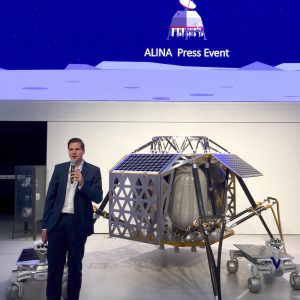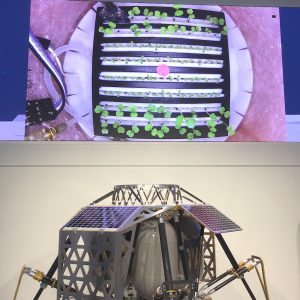
The Berlin, Germany-based start-up and Google Lunar X-Prize competitor, PTScientists , were invited on the evening of 14 July 2016 to the prestigious Volkswagen Forum, on Unter den Linden in the heart of Berlin, to present the ALINA lander to interested members of the press.
Robert Böhme, CEO and Founder of PTScientists, welcomed the press and took them on a Mission-to-the-moon. To achieve this mission, PTScientists have developed ALINA, the Autonomous Landing and Navigation Module, the first commercially available lander using European technologies, partners, and suppliers. Different configurations makes ALINA compatible with all major commercial launch solutions. A SpaceX Falcon-9, for example, can carry up to three ALINA modules in one launch.
To get to the Moon, the ALINA Module must be placed in a geostationary transfer orbit with an apogee of between 22,000 and 65,000 kilometers, from where ALINA can manage an orbital transfer, orbital insertion, and then landing on the surface of the Moon under its own propulsion. The lander can carry a total payload of 100 kilograms.
“Whether that is a lot depends on your perspective, since other landing modules are not commercially available, 100 kg is a big step in the right direction of commercial space.” said Robert Boehme.
The first ALINA mission – Mission-1 – will be dedicated to the Google Lunar X-Prize competition. This means a private mission to the moon, a soft landing on the surface, and the remote-controlled driving of a rover for at least 500-meters. On top of this, PTScientists must send an HD video of the manoeuvering rover back to Earth. The Google Lunar X-Prize competition runs until the end of 2017, and the winner will be awarded U.S.$30 million.
PTScientist’s Mission-1 payload are two Audi Lunar Quattro Rovers, designed in partnership with German automobile manufacturer Audi – a PT Scientist partner and sponsor – and were originally designed to meet and exceed the requirements of the Google Lunar X-Prize competition. The Audi Lunar Quattro Rovers can deliver and conduct mobile, on-surface experiments with a total mass of up to 10kg per unit, such as the Lunar Plant Growth experiment.

SpaceWatch Middle East sees a huge opportunity in the PTScientist’s Google Lunar X-Prize potential for strategic partnerships, research and development, and payload experiments with the new space powers in the Middle East. Any interested government, research institute, university, and corporate entity can join the PTScientists Mission to the Moon as partners, principal investigators, and sponsors.
However, the next steps for ALINA are a soft landing in the lunar Taurus-Littrow valley, where the Lunar Roving Vehicle from NASA’s Apollo program has been sitting for more than 43 years. The effects of the extreme Lunar environmental conditions there on the materials, such as the aluminium frame or the nylon safety belts, are completely unknown. Part of Mission-1’s goal is to investigate this.
The ALINA presentation finished with the announcement of a new project together with bestselling German science fiction writer Frank Schaetzing (author of The Limit and The Swarm) and an intense discussion with the audience.
SpaceWatch Middle East will report on the progress of this exciting project.
Original published at: http://spacewatchme.com/2016/07/alina-rocked-berlin/
 SpaceWatch.Global An independent perspective on space
SpaceWatch.Global An independent perspective on space

